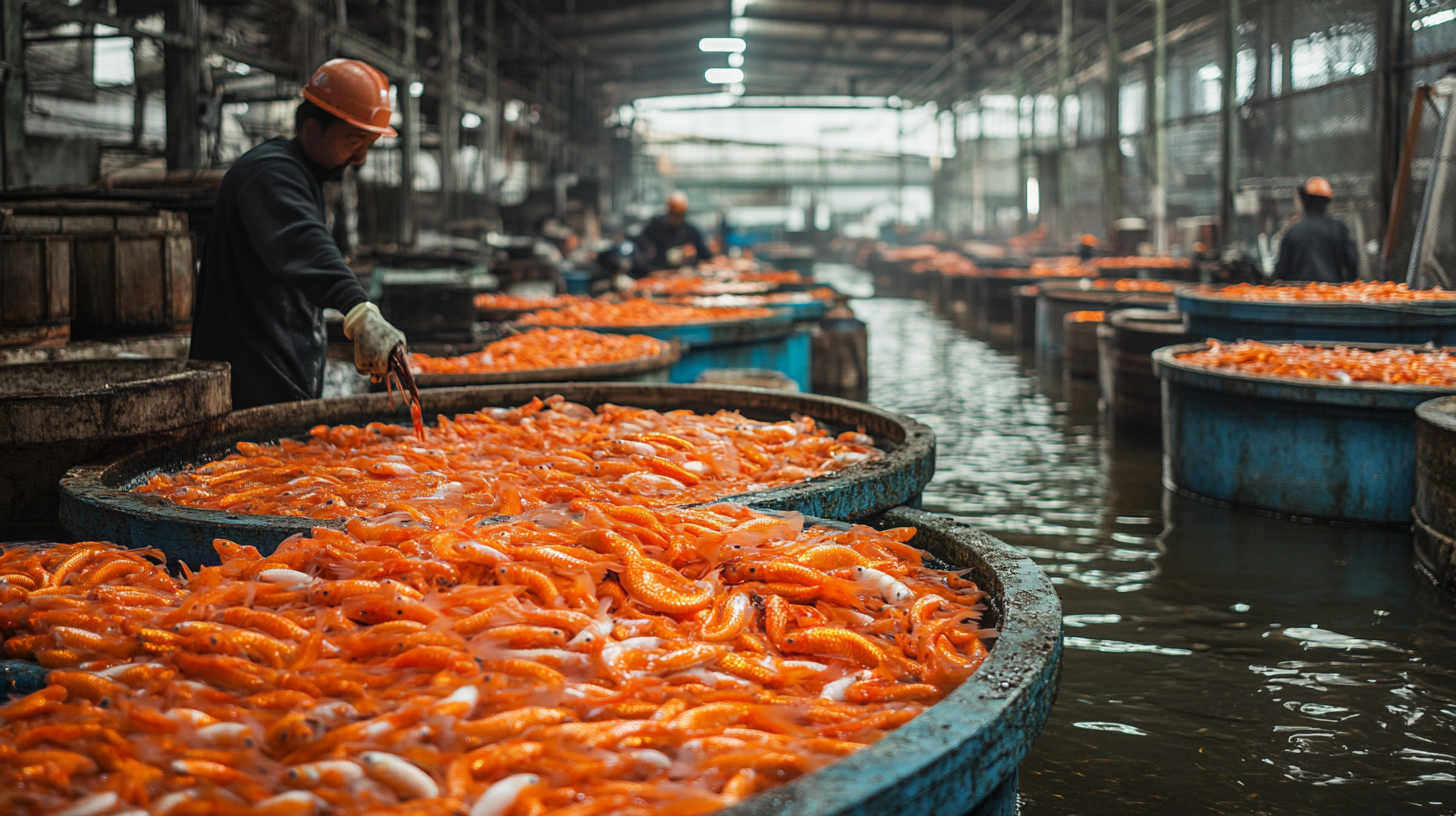Navigating Tariff Challenges: How China's Fish Pet Supply Industry Thrives Against Odds
In recent years, the Fish Pet Supply industry has encountered a myriad of challenges, particularly due to the escalating trade tensions between China and the United States, marked by reciprocal tariffs that have impacted multiple sectors. Despite these economic headwinds, the Chinese Fish Pet Supply sector has shown remarkable resilience and adaptability, thriving against the odds. The industry's growth can be attributed to innovative strategies, robust supply chains, and a burgeoning demand for pet fish products both domestically and internationally. This blog will delve into how Chinese manufacturers are navigating the complexities of international trade regulations, optimizing their operations, and capitalizing on emerging market trends. Through this exploration, we will uncover the secrets behind the impressive growth of the Fish Pet Supply industry as it successfully overcomes tariff challenges in a rapidly evolving global marketplace.

Strategies for Resilience: How Chinese Fish Pet Supply Manufacturers Adapt to Tariff Pressures
The Chinese fish pet supply industry has demonstrated remarkable resilience in the face of tariff pressures. Manufacturers have adopted innovative strategies to navigate these challenges, ensuring that they not only survive but also thrive. Key to their success has been a focus on diversifying supply chains and sourcing materials locally, which mitigates the effects of international tariffs and reduces reliance on foreign suppliers.
**Tip 1:** Consider building a robust local network of suppliers to lessen the impact of global market fluctuations. This not only secures supply chains but also fosters relationships within the community, bolstering overall business resilience.
Moreover, many manufacturers are leveraging technology and automation to enhance production efficiency. By investing in modern machinery and adopting smart production processes, they can lower operational costs and maintain competitive pricing in a tight market.
**Tip 2:** Explore digital transformations in your operations. Implementing AI and data analytics can streamline production and inventory management, helping you to respond more swiftly to market changes.
Lastly, embracing sustainable practices has become a critical strategy. Eco-friendly products not only appeal to the growing consumer demand for sustainability but often lead to reduced regulatory hurdles and potential tariff exemptions.
**Tip 3:** Focus on sustainability initiatives. Incorporating environmentally friendly materials and processes not only benefits the planet but can also position your brand favorably in an increasingly conscious market.
Navigating Tariff Challenges: How China's Fish Pet Supply Industry Thrives Against Odds
| Manufacturer | Product Type | Export Market | Tariff Impact (%) | Adaptation Strategy |
|---|---|---|---|---|
| FishLand Co. | Aquarium Supplies | USA | 25% | Cost reduction through local sourcing |
| Ocean Pets Ltd. | Fish Food | EU | 15% | Product reformulation |
| Aquatic Innovations | Tank Accessories | Canada | 20% | Increased efficiency in production line |
| Pet Ocean Inc. | Aquatic Plants | Australia | 10% | Diversifying product range |
Growth Metrics: Analyzing China's Fish Pet Supply Market Amidst Trade Challenges
The fish pet supply market in China has exhibited remarkable resilience amidst ongoing trade challenges, showcasing growth metrics that reflect a robust demand for aquatic pets and their accessories. According to a recent report by Market Research Future, the Chinese pet industry is expected to surpass USD 24 billion by 2025, with the fish segment contributing significantly to this growth. The increasing trend of urbanization and the rise of disposable incomes have led to a surge in pet ownership, with fish being one of the most favored choices due to their low maintenance needs.
Moreover, despite the tariff implications on imported goods, domestic production has flourished. The China Fishery Association highlights that local fish feed production has grown by over 10% annually, aiming to meet both the domestic demand and export requirements. Innovations in sustainable aquaculture practices and enhanced supply chain efficiencies are contributing to lower production costs, allowing local businesses to remain competitive. By leveraging these advantages and tapping into e-commerce channels, players in the fish pet supply industry are not only navigating tariff challenges but are actively expanding their market presence in a thriving pet industry landscape.
Navigating Tariff Challenges: China's Fish Pet Supply Market Growth
This chart illustrates the growth of China's fish pet supply market from 2018 to 2023 amid ongoing trade challenges and tariff issues. The data reflects the market size in billions of dollars throughout the years.
Innovative Solutions: Technological Advancements Driving Success in Fish Pet Supplies Industry
The fish pet supply industry in China has demonstrated remarkable resilience in the face of tariff challenges, largely due to innovative technological advancements that are reshaping the market landscape. One significant trend is the adoption of smart aquaculture technologies, which enable manufacturers to optimize production processes, reduce costs, and enhance product quality. By utilizing IoT devices and data analytics, companies can monitor water quality and fish health in real-time, ensuring a healthier environment for pet fish and fostering consumer trust.
Moreover, the integration of e-commerce platforms has revolutionized how businesses reach customers. By leveraging digital marketing strategies and personalized online shopping experiences, fish pet supply companies are effectively navigating tariff complications. Emphasis on sustainability and eco-friendly products also resonates with environmentally conscious consumers, further driving sales. As the industry continues to embrace these innovative solutions, it is well-positioned for growth and success despite the challenges presented by global trade dynamics.
Navigating Tariff Challenges in China's Fish Pet Supply Industry
Consumer Trends: The Rising Demand for Pet Fish Products in China and Beyond
The demand for pet fish products in China is on the rise, reflecting broader consumer trends that align with global pet ownership shifts. The pet food market, particularly within the aquatics sector, stands to grow significantly as consumers increasingly seek diverse options for their aquatic companions. The global fish meal market, forecasted to reach approximately USD 20.59 billion by 2034, indicates a booming industry that supports aquaculture and enhances the nutritional offerings for pet fish. This growth is not only limited to native fish species but also includes a variety of ornamental and tropical fish that consumers are passionate about.
To navigate this blossoming market, businesses focusing on fish pet products can employ a few strategic tips. First, investing in high-quality ingredients to ensure the health and well-being of fish will attract discerning pet owners who prioritize quality. Second, staying updated on market trends and consumer preferences can help brands tailor their products effectively. Lastly, engaging with the community through educational content about fish care can enhance brand loyalty and customer retention, turning casual buyers into dedicated enthusiasts. Such strategies can make a considerable difference in thriving amidst tariff challenges and competition.
As the landscape of the pet supply industry continues to evolve, the potential for innovative fish products remains vast. With the right approaches, businesses can effectively capitalize on the increasing interest in pet fish, thereby driving growth and stability in this unique segment of the market.

Trade Relations Impact: Assessing the Long-term Effects of US-China Tariffs on Fish Supply Chains
The fish pet supply industry in China is facing unprecedented challenges due to evolving trade relations with the United States, particularly the impact of tariffs imposed on imports. These tariffs have heightened the cost of goods and disrupted established supply chains, pushing suppliers to adapt swiftly to ensure survival. Chinese manufacturers have adopted innovative strategies, including diversifying their product lines and exploring new markets to offset losses from U.S. sales. This proactive approach not only helps to alleviate the immediate effects of tariffs but also positions them for long-term success in an increasingly competitive global market.
Moreover, the long-term effects of these tariffs may reshape the fish supply chain dynamics. Companies are beginning to source materials locally to minimize reliance on U.S. imports, fostering a more resilient domestic supply chain. This shift not only mitigates the impact of international trade barriers but also supports local economies. As the industry navigates these turbulent waters, it could ultimately lead to a more sustainable and self-reliant fish pet supply sector in China, demonstrating resilience against external pressures and setting a precedent for other industries facing similar challenges.

Copyright © 2021 Payless Pet Products - All Rights Reserved.